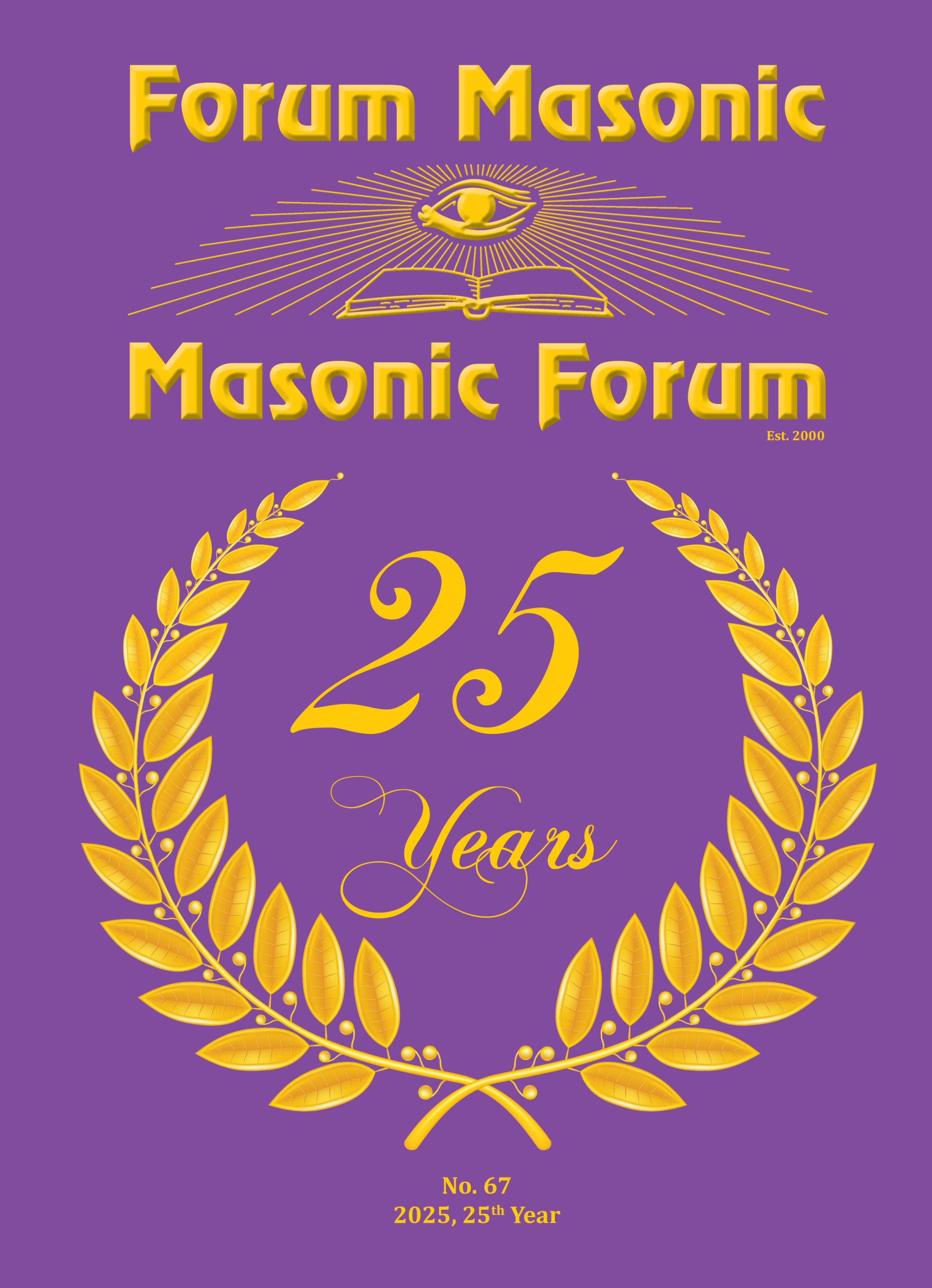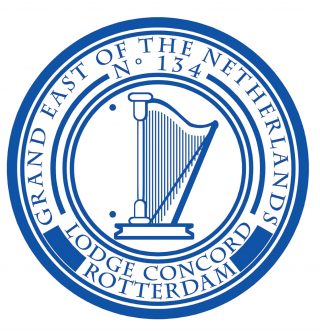
Thanks to my friend and brother, Gerard Otten, I had the opportunity to join, in June 2022, an exceptional meeting, in Rotterdam, of the English speaking CONCORD Lodge No. 134, within The Grand East of Netherlands. It was a first degree meeting. Two profanes were initiated, a Turkish and a Brazilian. The moving ceremony was highly appreciated by those in attendance as witnessed by various reactions and comments (especially from visitors). Credit must go to the Master and his Officers who carried out their roles in fine fashion, again showing the benefit of practice and rehearsal. Further ritual was performed in style by W Bro A.G. Brouwer (NE Corner Charge), Bro R. Hall (Working Tools) and W Bro M van der Linden (Charge after Initiation). The lodge is very cosmopolitan, bringing together Masons of various nationalities. The membership now includes the lands of the Roman Empire plus colonies and, strange enough, hardly German Bethren.
The atmosphere was extraordinary. Another proof of the universality of Freemasonry. I have traveled a lot, taking part in various Masonic meetings around the Globe. I have been dealing with international masonic relations for 22 years, since I founded the Masonic Forum Magazine, and I am therefore used to the atmosphere in different lodges, practising various rituals. I felt at home in Concord Lodge, as I did in my lodges in England, Scotland and Germany. As a result, I decided to become a Country Member of the Grand East of Netherlands.
As a tribute to the CONCORD Lodge, one of my new Masonic homes, I decided to publish in Masonic Forum Magazine a short history of this exceptional lodge. So, I asked the seniors of CONCORD to provide me information about this lodge, established almost a century ago in 1929.
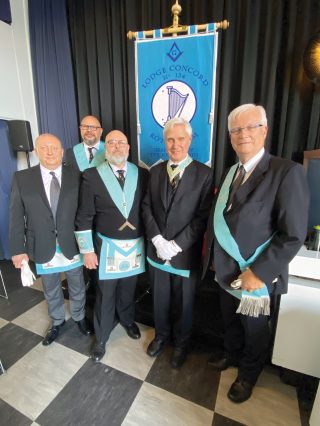
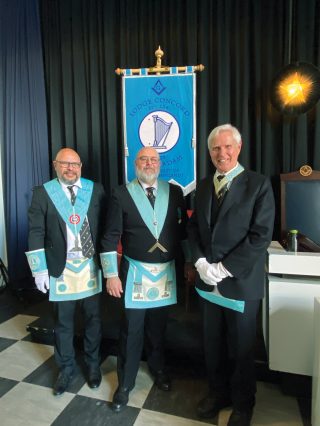
THE BEGINNINGS OF FREEMASONRY IN THE NETHERLANDS
Records show us that already in 1724 there was a working Freemasons Lodge in Rotterdam. This was definitively the first lodge in Holland and most probably the first lodge on the continent. Its members consisted of English and Scottish merchants who were living here in Rotterdam and local business companions. Fifteen years later other lodges sprung up in The Hague and Amsterdam.
It became known that to become a member of a lodge one had to swear an oath of secrecy, including a most severe penalty on the breaking of that oath. The government learning about this at once decreed Freemasonry illegal. Two reasons were underlying this decision: first a society working in secret could be plotting subversive actions and secondly only government and local authorities are licensed to apply punishment on their citizens. In 1736 Government: that was “De Staten van Holland” published a decree banning Freemasons lodges. As a consequence the Rotterdam Lodge was dissolved. In the following 12 years this ban was strictly enforced. Gradually however enforcement was slackened and new lodges sprung up. In 1756 this resulted in 11 Dutch lodges deciding to found their own Dutch Grand Lodge.
Already in 1747 a new English speaking lodge: “the Orange Lodge” was established in Holland. It harboured many nationalities. As is often the case in mixed companies dissent sprung up and members tended to club together on basis of a shared language. Apart from several English speaking lodges French and German speaking lodges came into existence. One of those (then English speaking) Lodges is still existing here in Rotterdam it is: ”the 3 Pillars Lodge” (De Drie Kolommen) founded in 1767 as a London‑chartered lodge but it is nowadays a Dutch lodge under the Grand East of the Netherlands working the Dutch ritual in the Dutch language.
Now let us return to Holland after the Great War. A period of expanding economic life. As in the 18th century when Freemasonry came to Holland the city of Rotterdam being a major port with a considerable trade between Europe and the U.K. harboured quite a lot of English, Scottish and Colonial brethren all speaking English. They consisted of Merchants/Shipping Agents/Seafaring Brethren and their relations and friends.
It has been established that a substantial group of these brethren were then members or regular visitors of Lodge Drie Kolommen, among whose members were many brethren engaged in the same maritime related activities. Business relations must also have played a part in their joint membership.
It is interesting to see how history repeats itself from the 18th to the 20th century in a Dutch Lodge which started off with an English speaking membership of merchants and maritime people which later on switched to using the Dutch language. And which after a 150 years again became a harbour for English speaking Expats/Travellers & Seafaring men.
Most probably it has been the size of the English speaking contingent and the support of their fellow brethren of Lodge 3 Kolommen that made them bold enough in January 1929 (well before the economic crisis set in) to apply to the Grand East of the Netherlands to grant them a warrant to start a Dutch Lodge in Rotterdam working in the English language.
These petitioning brethren were P. Deys / Wallace T. Platt / G.V. Hartree / R.W. Berkhout / G. Dulling/ B. Massey / J. Springer.
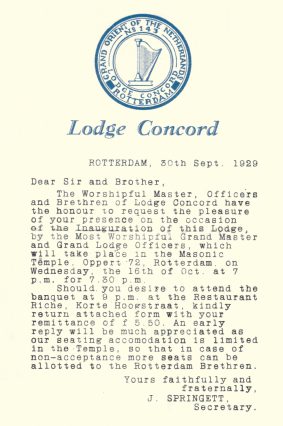
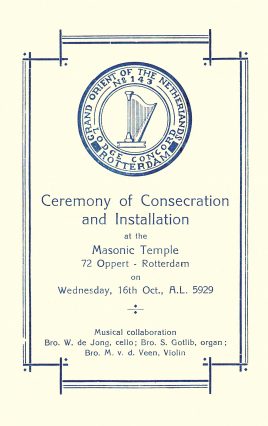
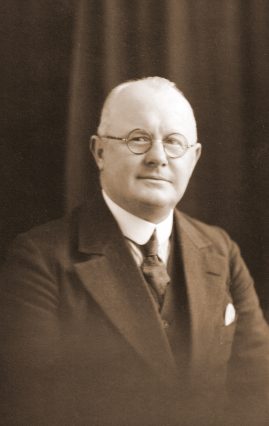
In June 1929 at the Annual Meeting of the Grand East of the Netherlands their petition was considered and agreed upon.
Lodge Concord No 134 was then consecrated on the 16th October 1929 by the then reigning Grand Master M.W. Bro Hermannus van Tongeren.
The first W.M. of Lodge Concord was Bro W.T. Platt.
In Holland every lodge has to choose a colour. The chosen colour for Concord Lodge was Light Blue. Most probably this colour was chosen to enable the English brethren to wear their English regalia.
Lodge Concord was permitted to follow the English Constitution in its administration provided it did not contravene with the Grand East of the Netherlands Constitution.
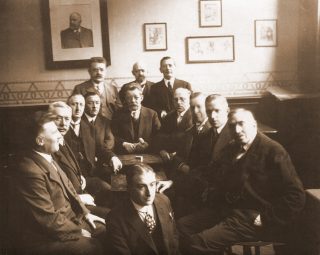
It must be noted that the new Lodge although being given great support by Lodge 3 Kolommen was not its daughter lodge so lodge De Drie Kolommen is not the Mother Lodge.
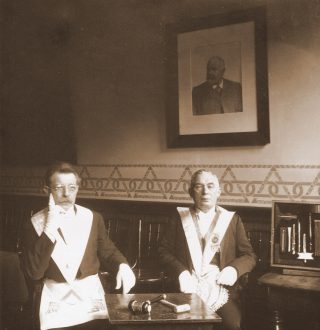
Although the new lodge was allowed to use the English language, the working of the ritual was compulsory a translation of the Dutch ritual at that moment in use in Holland. Also the officers were to be the equivalent of the officers in the Dutch lodges. This may seem strange to all accustomed to working the English Emulation ritual in a Lodge with the accompanying offices as prescribed by that ritual. But those were the conditions upon which the new lodge was allowed to come into being. In fact quite the same conditions as now rule the newly founded Amsterdam lodge in Amsterdam, to which lodge Concord has given every support but which is not our daughter Lodge.
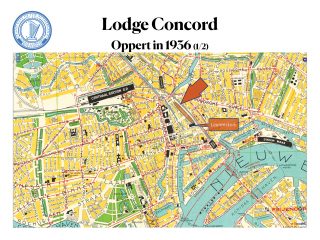
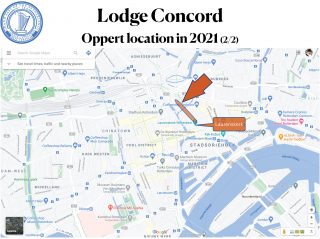
Little is known about the pre‑war functioning of Lodge Concord. We know that the first W.M.: W.T. Platt (1929‑30) was succeeded by P. Deys (1930‑2), who was the driving power of the founding of Lodge Concord. Piet Deys was succeeded by the BB J. Springett (1932‑3), L.W. Davies (1933‑4), E. Hart (1934‑5), G. Gibbs (1935‑6), and I. Garrett (1936‑7).
We have no knowledge of the masters and officers during the years after 1937 up to the outbreak of W.W. II.
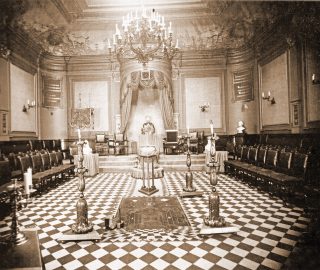
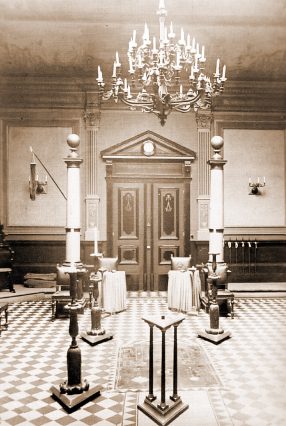
Like most of the other Rotterdam Lodges, Concord used the same lodge building at the OPPERT No 72 (property of Lodge 3 Kolommen).
Concord also seems to have participated in the combined annual Opening of the Working Year of the other Rotterdam lodges. Like we still do now. They assembled monthly, instituted later on a line of Officers, and subsidized their Ladies’ Night, as is the case this very day.
The bombardment of Rotterdam in May 1940 destroyed the lodge building at the Oppert and all lodge records of the Rotterdam Lodges stored there. No further trace of our pre‑war history remains.
All masonic activities ceased during the German occupation.
We have no knowledge about the fate of the brethren of Lodge Concord after the beginning of the occupation. Whether the English brethren succeeded in regaining their own country and if all brethren survived the war is sadly unknown.
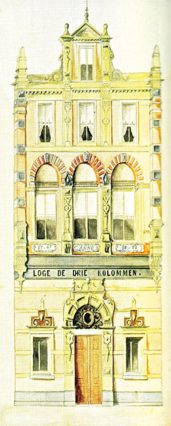
RESUSCITATION OF CONCORD LODGE
There is one argument for continuity between the old Concord from 1929 and the resuscitated Concord from 1956 in the person of Brother Henk ‘Henry’ Lohman, who had been admitted in Concord in 1935 before WWII, and was its Secretary Designate in 1956. Brother Herman van Well had not seen Brother Lohman at his initiation in 1969, and indeed, Brother Lohman was absent between 1956 and 1972; he was country member of the Lodge between 1972 and his passing away in 1979, and only attended with some regularity between 1972 and 1977. He was by then PM and a Grand Officer (P.D.A.G.D.C.) of the District Grand Lodge of Egypt and the Sudan. Here we are not far from the series Dad’s Army, this District Grand Lodge having been led around 1900 by no other than Lord Kitchener himself. Brother Lohman had returned from the Suez Canal, in 1950 and then became a member of DDK.
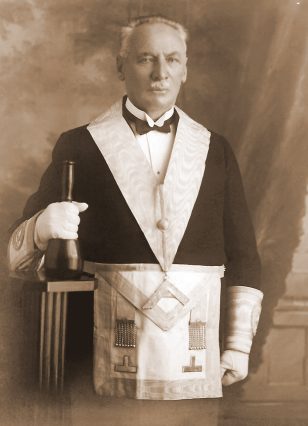
Brother Lohman was present at the resuscitation meeting in his capacity of Secretary, but did not write any minutes nor was mentioned therein. Neither was he mentioned in the list of resuscitating members.
Brother Jan‑Albert Dop communicated to us that he remembered only 2 great secretaries in Concord, namely Brother Cees Timmer and Brother Joe Foreman. But Brother Foreman had been the Secretary of Concord MMM Lodge! Herewith Brother Jan‑Albert had set us on a trail.
In his history of Lodge Concord (2003), Brother Derek Seaman suggests that the Lodge was resuscitated by some members of pre‑war Lodge Concord, together with their friends from the countryside of England, and some keen Brethren from Holland.
On the 29th of September 1956 at 16:30 the Dutch Grand Master, Grand SW & JW, Secretary, Treasurer and DC attended the resuscitation ceremony. From UGLE came a Grand Assistant Chaplain, and two Officers with Past Grand Rank, whilst the other four installing Officers were resuscitating members of Concord. In attendance were 24 Officers & members (out of 26) and 75 visitors (32 names on loose sheets, another a certain Brother J. Foreman of Avondale Lodge No. 2395. The building could accommodate 100 persons.
The Grandmaster opened the Lodge, he expressed happiness that Concord was now the 6th resuscitated Lodge after WW II, and he and his Wardens opened in Dutch fashion in the 1st Degree. Then he invited the Installing Officers in reverse order of rank to install Brother Cornelis Manifarges as WM of Lodge Concord and handed the warrant to the Installing Master.
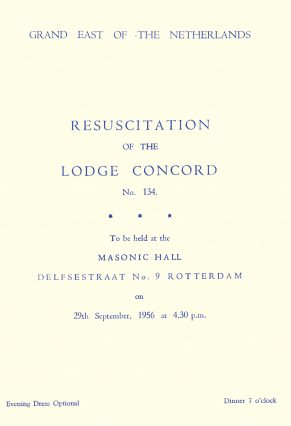
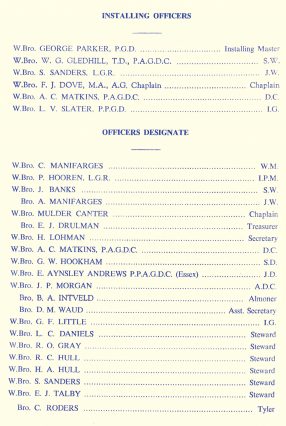
The Ceremony went smoothly, WBrother C. Manifarges being obligated and duly installed in a short inner working; he invested as IPM WBrother P.J. Hooren. Followed announcement and balloting of the candidate for next meeting (he was from Essex), appointment and investment of the Officers, definition of the colour of the Lodge, an arrangement for the by‑laws to be written, (no collection?) the risings, and closure. They must have been through around 18:00h.
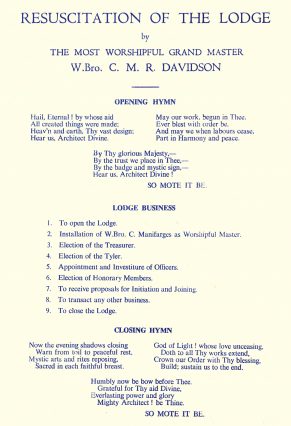
In 1973 Antonie Manifarges wrote explicitly that Lodge Concord had been resuscitated on the initiative of his father. Brother Cornelis Manifarges was then a member of Lodge The Three Pillar’s (DDK), since 1936. DDK is even now one of the three biggest Rotterdam Lodges. In 1958 it had some 150 members, notwithstanding having given birth recently to Lodge The Three Lights (DDL) and Lodge Delta. So, when Brother Cornelis Manifarges must have won at least 4 other Brethren from DDK for the idea (Brothers Lohman, Drulman, Waud, and Van den Akker), this must have been felt by DDK as just another investment, like DDK had been doing continually. But, there were not many English Masons working in the harbour on the list of DDK. In fact, the BB Waud and Manifarges were the only ones!
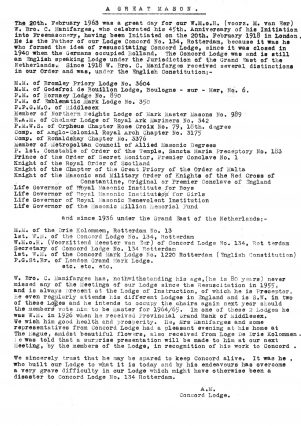
Why did Brother Manifarges choose for a typical English set up? Maybe he feared that the Lodge would be destroyed again if the English would be forced to leave; the continent of Europe was by then not considered that safe because of the Russian threat. Next to that, he felt probably more expert in the English ritual, and as DDK hardly had other English members such as he, he would have to import them. For English Masons to be of interest, Lodge Concord needed an English set‑up cq an English ritual they were familiar with. It would become more affordable as well, since most English Craft Lodges meet only 4‑5 times per year, and in a Dutch set‑up with weekly/monthly meetings traveling costs would be high for Brethren residing in the UK.
It was unlikely that an English set‑up, although necessary for the resuscitation of Concord Craft, would be sufficient in itself to motivate his friends to cross the Channel at least four times per year. He would need something more to compensate his friends for all the hassle and costs of traveling 4‑5 times per year to the Continent. What could be attractive to them would be the introduction of a side degree in Europe. Which side Degree would be suitable?
If one would choose to use the English ritual, for instance Emulation, the way for founding a Mark Lodge would be open, for most friends of Brother Manifarges from Middlesex and the surrounding counties had, as he did, Provincial rank in the Mark. So, for Brother Cornelis, the way to interest his friends from the Mark in an enterprise such as resuscitating Concord Craft, was to go for the foundation of a Mark Lodge as quick as possible after the resuscitation of the Craft Lodge.
(As everybody knows, since 1816 an English Lodge is not considered complete without a Chapter of the Holy Royal Arch. So, why was the HRA not chosen? Probably Brother Cornelis Manifarges had enough experience with Dutch Masonry to foresee that the Dutch HRA Grand Chapter would insist on an English translation of its own ritual for the sake of ritual uniformity. Moreover, he had never led a Chapter of the HRA himself. Thus, foundation of a Concord HRA Chapter would and could have to wait).
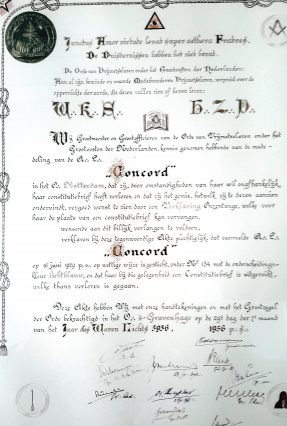
Cornelis knew that the new Mark Lodge would be the first one on the Continent of Europe and he must have probed Mark Grand Lodge and (maybe) even UGLE about their interest in this undertaking before actually deciding to the actual resuscitation of Concord Craft. Of course, Mark Masons Hall must have been very interested, the UGLE probably willing to cooperate as long as the Dutch Craft would be agreeable and the Dutch HRA Grand Chapter not offended. They may have been pleased to see an English set‑up imported in the Dutch fortress, but would proceed low‑key, in order not to unnecessarily ruffle Masonic feathers.
And so, Concord Mark Master Masons Lodge was founded in April 1958, 19 months since the first regular meeting of Concord Craft after its resuscitation. In 1966 the RAM Lodge was founded. In May 1979 Concord HRA Chapter was established. Concord’s side degrees, Mark‑RAM‑Royal Arch have developed into interfaces of various English speaking Lodges in the Netherlands.
Nowadays, Concord is not the greatest Craft Lodge in Rotterdam, that is Fréderic Royal. But if we add the membership of Mark/RAM/HRA, (not the duplicates) then Concord is the biggest corpus in Rotterdam; also the visitors made Concord to what it is.
There is an atmosphere of openness and friendliness towards visitors. This atmosphere has always remained the same, even if the membership is nowadays from the countries that belonged to the whole Roman Empire and colonies, and that is maybe a secret of the Lodge’s success. Another pleasing thing is that the climate of the Lodge is serious, but not solemn. How to convey in a precise way the special atmosphere we do not know. The best way is to experience it yourself. n
(Info provided by WBros. Herman van Well, Anne Brouwer)
